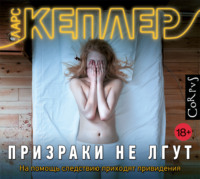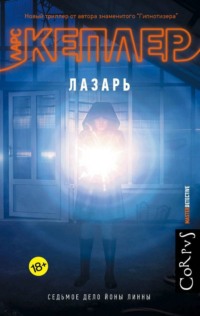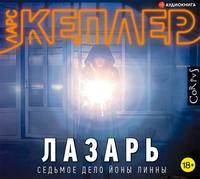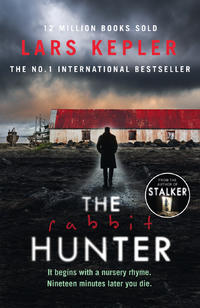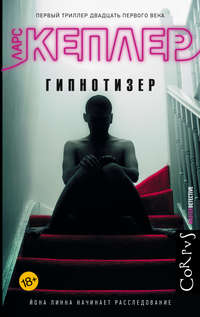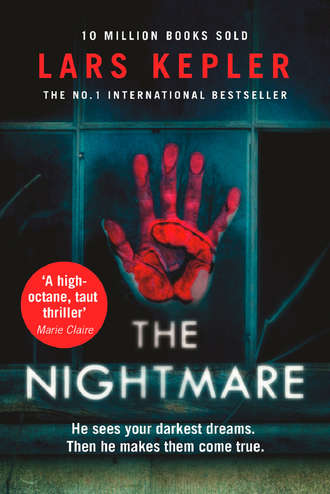
Полная версия
The Nightmare
He was only going to have lunch with Disa at Rosendal Garden on Djurgården. Joona got there early and stood in the sunshine for a while watching the mist that lay over the little vineyard. Then he saw Disa walking towards him, her bag swinging over her shoulder. Her thin face with its intelligent features was covered with early-summer freckles, and her hair, usually gathered in two uneven plaits, was for once hanging loose over her shoulders. She had dressed up, and was wearing a floral-patterned dress and a pair of summery sandals with a stacked heel.
They hugged tenderly.
‘Hello,’ Joona said. ‘You look lovely.’
‘So do you,’ Disa said.
They got food from the buffet and went and sat at one of the outdoor tables. Joona had noticed she was wearing nail varnish. As a senior archaeologist, Disa’s fingernails were usually short and rather dirty. He looked away from her hands, across the fruit garden.
Disa started to eat, and said with her mouth full:
‘Queen Christina was given a leopard by the Duke of Courland. She kept it out here on Djurgården.’
‘I didn’t know that,’ Joona said calmly.
‘I read in the palace accounts that the Treasury paid forty silver riksdaler to help cover the funeral costs of a maid who was killed by the leopard.’
She leaned back and picked up her glass.
‘Joona Linna, stop talking so much,’ she said sarcastically.
‘Sorry,’ Joona said. ‘I …’
He tailed off and suddenly felt as if all the energy were draining from his body.
‘What?’
‘Please, keep talking about the leopard.’
‘You look sad …’
‘I was thinking about Mum … It was exactly a year ago yesterday that she died. I went and left a white iris on her grave.’
‘I miss Ritva a lot,’ Disa said.
She put her knife and fork down and sat quietly for a while.
‘Do you know what she said the last time I saw her? She took my hand,’ Disa said. ‘And then she said I ought to seduce you, and make sure I got pregnant.’
‘I can imagine,’ Joona laughed.
The sun sparkled in their glasses and reflected off Disa’s unusually dark eyes.
‘I said I didn’t think that would work, and then she told me to leave you and never look back, never come back.’
He nodded, but didn’t know what to say.
‘And then you’d be all alone,’ Disa went on. ‘A big, lonely Finn.’
He stroked her fingers.
‘I don’t want that.’
‘What?’
‘To be a big, lonely Finn,’ he said softly. ‘I want to be with you.’
‘And I want to bite you, quite hard, actually. Can you explain that? My teeth always start to tingle when I see you,’ Disa smiled.
Joona reached out his hand to touch her. He knew he was already late for the meeting with Carlos Eliasson and the National Homicide Commission, but went on sitting where he was, chatting and simultaneously thinking that he ought to go to the National Museum to look at the Sami bridal crown.
While he was waiting for Joona Linna, Carlos Eliasson had told the National Homicide Commission about the young woman who had been found dead in a motor cruiser in the Stockholm archipelago. In the minutes of the meeting Benny Rubin noted that the case wasn’t urgent, and that they were going to wait for the marine police’s own investigation.
Joona arrived late for the meeting, and barely had time to sit down before Police Constable John Bengtsson called him. They had known each other for years, and had played indoor hockey against each other for over a decade. John Bengtsson was a likeable man, but when he was diagnosed with prostate cancer almost all of his friends vanished. Nowadays John Bengtsson was completely well again, but, like many people who had felt death breathing down their neck, there was something sensitive and hesitant about him.
Joona stood in the corridor outside the conference room listening to John Bengtsson’s protracted account of what he had found. His voice was full of the weariness that arises in the minutes following extreme stress. He described how he had just found the director general of the Inspectorate for Strategic Products hanging from the ceiling in his own home.
‘Suicide?’ Joona asked.
‘No.’
‘Murder?’
‘Can’t you just come over?’ John asked. ‘Because I can’t make sense of this. The body’s floating above the floor, Joona.’
Together with Nathan Pollock and Tommy Kofoed, Joona had just concluded that they were dealing with a case of suicide when the doorbell of Palmcrona’s home rang. In the darkness of the landing stood a tall woman holding shopping bags in her large hands.
‘Have you taken him down?’ she asked.
‘Taken down?’ Joona repeated.
‘Mr Palmcrona,’ she said matter-of-factly.
‘What do you mean, taken down?’
‘I’m sorry, I’m only the housekeeper, I thought …’
The situation clearly troubled her, and she started to walk down the stairs, but stopped abruptly when Joona replied to her initial question:
‘He’s still hanging there.’
‘Yes,’ she said, and turned to him with a completely neutral expression on her face.
‘Did you see him hanging there earlier today?’
‘No,’ she replied.
‘What made you ask if we’d taken him down? Had something happened? Did you notice anything unusual?’
‘A noose from the lamp-hook in the small drawing room,’ she replied.
‘You saw the noose?’
‘Of course.’
‘But you weren’t worried that he might use it?’ Joona asked.
‘Dying isn’t such a nightmare,’ she replied with a restrained smile.
‘What did you say?’
But the woman merely shook her head.
‘What do you imagine his death looked like?’ Joona asked.
‘I imagine that the noose tightened round his throat,’ she replied in a low voice.
‘And how did the noose get to be round his neck?’
‘I don’t know … perhaps it needed help,’ she said quizzically.
‘What do you mean by help?’
Her eyes rolled back and Joona thought she was going to faint before she reached out for the wall with one hand and met his gaze again.
‘There are helpful people everywhere,’ she said weakly.
8
Nils Åhlén
The swimming pool at Police Headquarters is silent and empty, the glass wall dark and there’s no one in the cafeteria. The large blue pool is almost perfectly still. The water is illuminated from below and the glow undulates gently across the walls and ceiling. Joona Linna swims length after length, maintaining a steady speed and controlling his breathing.
As he swims, memories tumble through his consciousness. Disa’s face as she told him her teeth tingled when she looked at him.
Joona reaches the edge of the pool, turns beneath the water and kicks off. He isn’t aware that he is swimming faster when his thoughts suddenly focus on Carl Palmcrona’s apartment on Grevgatan. Once again he is looking at the hanging body, the pool of urine, the flies on the face. The dead man had been wearing his outdoor clothes, his coat and shoes, but had still taken the time to put some music on.
The whole thing had given Joona the impression of being both planned and impulsive, which is far from unusual with suicides.
He swims faster, turns and speeds up even more, and in his mind’s eye sees himself crossing Palmcrona’s hall to open the door when the bell rang. He sees the tall woman with big hands standing concealed behind the door, in the darkness of the stairwell.
Joona stops at the edge of the pool, breathing hard, and rests his arms on the plastic grille covering the overspill channel. His breathing soon calms down, but the heaviness of the lactic acid in his muscles is still increasing. A group of police officers in gym clothes come into the hall. They’re carrying two life-saving dummies, one representing a child, the other someone badly overweight.
Dying isn’t such a nightmare, the tall woman had said with a smile.
Joona climbs out of the pool with an odd feeling of unease. He doesn’t know what it is, but the case of Carl Palmcrona’s death won’t leave him alone. For some reason he keeps seeing the bright, empty room, hearing the gentle violin music along with the dull buzzing of the flies.
Joona knows they’re dealing with a suicide, and tries to tell himself that it’s no concern of the National Crime Unit. But he still feels like running back to the scene of the discovery again and examining it more thoroughly, searching every room, just to see if he missed anything.
During his conversation with the housekeeper he had imagined that she was confused, that shock had settled around her like dense fog, making her answers opaque and incoherent. But now he tries to look at it the other way round. Perhaps she wasn’t at all shocked or confused, and had answered his questions as accurately as she could. In which case the housekeeper, Edith Schwartz, was claiming that Carl Palmcrona had help with the noose, and there were helping hands, helpful people. In which case she was saying that his death wasn’t a self-imposed act, and that he hadn’t been alone when he died.
There’s something that doesn’t make sense.
He knows he’s right, but he can’t identify what the feeling is.
Joona goes through the door to the men’s changing room, opens his locker, takes out his phone and calls senior pathologist Nils “The Needle” Åhlén.
‘I’m not finished,’ The Needle says when he answers.
‘It’s about Palmcrona. What are your first impressions, even if …?’
‘I’m not finished,’ The Needle repeats.
‘Even if you’re not finished,’ Joona says, finishing his sentence.
‘Call in on Monday.’
‘I’m coming now,’ Joona says.
‘At five o’clock I’m going to look at a sofa with my wife.’
‘I’ll be with you in twenty-five minutes,’ Joona says, and ends the call before The Needle can repeat that he isn’t finished.
As Joona showers and gets dressed, he hears the sound of children laughing and talking, and realises that a swimming lesson is about to start.
He ponders the significance of the fact that the director general of the Inspectorate for Strategic Products has been found hanged. The person who, when it comes down to it, takes all the final decisions about Swedish arms manufacture and export, is dead.
What if I’m wrong, what if he was murdered after all? Joona asks himself. I need to talk to Pollock before I go and see The Needle, because he and Kofoed may have had a chance to look at the material from the crime scene investigation.
Joona strides along the corridor, runs down a flight of steps and calls his assistant, Anja Larsson, to find out if Nathan Pollock is still in Police Headquarters.
9
About close combat
Joona’s thick hair is still soaking wet when he opens the door to Lecture Room 11 where Nathan Pollock is giving a lecture to a select group of men and women who are training to handle hostage situations and rescues.
On the wall behind Pollock is a computer projection of an anatomical drawing of the human body. Several different types of handgun are laid out on a table, from a small, silver Sig Sauer P238 to a matt-black assault rifle from Heckler & Koch with a 40mm grenade launcher attachment.
One of the young officers is standing in front of Pollock, who pulls a knife, holds it concealed against his body, then rushes forward and pretends to cut the officer’s throat. Then he turns to the group.
‘The disadvantages of that sort of attack are that the enemy may have time to cry out, that the movement of the body can’t be controlled, and it takes a while for them to bleed out because you’ve only opened one artery,’ Pollock explains.
He goes over to the young officer again and wraps his arm around his face, so that the crook of his arm is covering his mouth.
‘But if I do it this way instead, I can muffle any scream, manoeuvre his head and sever both arteries with a single cut,’ he says.
Pollock lets go of the young officer and notices that Joona Linna is standing just inside the door. He must have only just arrived, while he was demonstrating those two grips. The young police officer wipes his mouth and sits back down in his chair. Pollock smiles broadly and waves at Joona, beckoning him forward, but Joona shakes his head.
‘I’d like a few words, Nathan,’ he says quietly.
Some of the officers turn to look. Pollock walks over to him and they shake hands. Joona’s jacket is dark where his wet hair has touched it.
‘Tommy Kofoed secured shoeprints from Palmcrona’s home,’ Joona says. ‘I need to know if he found anything unexpected.’
‘I didn’t think there was any urgency?’ Nathan replies in a muted voice. ‘Obviously we photographed all the impressions, but we haven’t had time to analyse the results. I can’t give you any sort of overall picture right now …’
‘But you did see something,’ Joona says.
‘When I put the images into the computer … it could be a pattern, but it’s too early to …’
‘Just tell me – I have to go.’
‘It looks like there were prints from two different set of shoes moving in two circles around the body,’ Nathan says.
‘Come with me to see Nils Åhlén,’ Joona says.
‘Now?’
‘I’m supposed to be there in twenty minutes.’
‘Damn, I can’t,’ Nathan replies, gesturing towards the room. ‘But I’ll have my phone on in case you need to ask anything.’
‘Thanks,’ Joona says, and turns to leave.
‘You … you don’t want to say hello to this lot?’ Nathan asks.
They’ve all turned round now and Joona gives them a brief wave.
‘So, this is Joona Linna, who I’ve told you about,’ Nathan Pollock says, raising his voice. ‘I’m trying to persuade him to come and give a lecture on close combat.’
The room falls silent as they all look at Joona.
‘Most of you probably know more about martial arts than I do,’ Joona says with a slight smile. ‘The only thing I’ve learned is … when it’s real, there are suddenly completely different rules. No art, just fighting.’
‘Pay attention to this,’ Pollock says keenly.
‘In reality you only survive if you have the ability to adapt to changing circumstances and turn them to your advantage,’ Joona goes on calmly. ‘Practise making the most of the circumstances … you might be in a car, or on a balcony. The room might be full of teargas. Maybe the floor is covered with broken glass. There may be weapons, other implements. You don’t know if you’re at the start or the end of a chain of events. So you need to save your energy so you can keep working, so you can get through a whole night … So any flying kicks and cool roundhouse kicks are out of the question.’
A few of them laugh.
‘In unarmed close combat,’ Joona goes on, ‘it’s often a matter of accepting some pain in order to bring things to a rapid conclusion … but I don’t really know much about this.’
Joona walks out of the lecture room. Two of the officers clap. The door closes and the room falls silent. Nathan Pollock smiles to himself as he walks back to the table.
‘I was actually planning to save this for a later occasion,’ he says, and clicks the computer. ‘This recording is already a classic … from the hostage drama at the Nordea Bank on Hamngatan nine years ago. Two robbers. Joona Linna has already got the hostages out, and has incapacitated one of the men, who was armed with an Uzi. It was a fairly vicious fire-fight. The other guy is hiding, but only armed with a knife. They’d sprayed all the security cameras, but missed this one … We’ll take it in slow motion because it only lasts a matter of seconds.’
Pollock hits play and the film starts. A grainy shot of a bank filmed from above comes into view. The seconds tick by on the timer at the bottom of the screen. The furniture has been thrown about, the floor is littered with paper and documents. Joona is moving smoothly sideways, his pistol raised, his arm straight. He’s moving slowly, as if underwater. The bank robber is hiding behind the open vault door with a knife in his hand. Suddenly he darts forward with long, smooth strides. Joona turns the pistol on him, aiming straight at his chest, and fires.
‘The pistol clicks,’ Pollock says. ‘Faulty bullet stuck in the chamber.’
The grainy footage flickers. Joona moves backwards as the man with the knife rushes at him. The whole thing is eerily silent and fluid. Joona ejects the cartridge, but realises that he’s not going to have time. Instead he turns the useless pistol round, so that the barrel runs parallel to the bone in his lower arm.
‘I don’t get it,’ one woman says.
‘He turns the pistol into a tonfa,’ Pollock explains.
‘A what?’
‘It’s a sort of baton … like the ones the American police use, it extends your reach and increases the power of any blow because the area of impact is smaller.’
The man with the knife has reached Joona. He takes a long, hesitant step. The knife-blade glints as it describes a semi-circle, aimed at Joona’s torso. The man’s other hand is raised, and follows the rotation of his body. Joona isn’t even looking at the knife, and moves forward instead, taking a long stride and striking hard as he does so. He hits the man on the neck, just below his Adam’s apple, with the barrel of the pistol.
The knife spins as it falls towards the floor as if in a dream, and the man sinks to his knees, opens his mouth wide, clutches his neck and then collapses to the floor.
10
Drowned
Joona Linna is sitting in his car on Fleminggatan, on his way to the Karolinska Institute in Solna, thinking about Carl Palmcrona’s hanging body, the tense washing-line, the briefcase on the floor.
In his mind Joona tries adding the two circles of shoeprints on the floor around the dead man.
This case isn’t over yet.
Joona turns onto Klarastrandsleden. He drives along the side of the canal where the trees have already woven their leafy baskets, leaning into the water, sinking their branches into the smooth, mirror-like surface.
In his mind’s eye he sees the housekeeper, Edith Schwartz, again – every detail, the veins on the large hands holding the bags of shopping, and the way she said that there are helpful people everywhere.
The Department of Forensic Medicine is situated among the trees and neat lawns of the large Karolinska Hospital campus, a red-brick building at Retzius väg 5, surrounded by large buildings on all sides.
Joona pulls into the empty visitors’ car park. He notes that senior pathologist Nils Åhlén has driven over the kerb and parked his white Jaguar in the middle of the lawn next to the main entrance.
Joona waves to the woman in reception, who responds by giving him the thumbs-up, and he carries on along the corridor, knocks on Nils Åhlén’s door and walks in. As usual, The Needle’s office is utterly free from superfluous objects.
The blinds are drawn, but the sunlight is still filtering in between the blades. The light reflects off all the white surfaces, but sinks into the expanses of brushed grey steel.
The Needle is wearing his white-framed aviator glasses and a white polo-neck under his white coat.
‘I’ve just issued a parking ticket to a badly parked Jaguar outside,’ Joona says.
‘Good,’ Nils says.
Joona stops in the middle of the floor and becomes serious. His eyes turn silvery dark.
‘So, how did he die?’ he asks.
‘Palmcrona?’
‘Yes.’
The phone rings and The Needle nudges the post-mortem report towards Joona.
‘You didn’t have to come all the way out here to get an answer to that,’ he says before picking up the receiver.
Joona sits down opposite him on the chair with a white leather seat. The post-mortem on Carl Palmcrona’s body is finished. Joona leafs through it, stopping to read different passages at random.
74. Kidneys weight a total of 290 grams. Smooth surface. Tissue grey-red. Consistency firm, elastic. Clear delineation.
75. Urinary ducts appear normal.
76. Bladder empty. Mucous membrane pale.
77. Prostate normal size. Tissue pale.
The Needle nudges his aviator glasses up his narrow, bent nose, then ends the phone call and looks up.
‘As you can see,’ he says with a yawn, ‘there’s nothing unexpected. Cause of death is asphyxia … With a full-blown hanging, of course, it’s rarely a matter of suffocation in the common sense, but of a blockage of the arteries.’
‘The brain suffocates because the supply of oxygenated blood stops.’
The Needle nods.
‘Arterial compression, bilateral constriction of the carotid arteries, and of course it happens very fast, he would have been unconscious within a matter of seconds …’
‘But he was still alive before he was hanged?’ Joona asks.
‘Yes.’
The Needle’s thin face is clean-shaven and gloomy.
‘Can you estimate the height of the drop?’ Joona asks.
‘There are no fractures in the cervical spine or the base of the skull – so I’d guess ten, twenty centimetres.’
‘Right …’
Joona thinks about the briefcase and the prints from Palmcrona’s shoes. He opens the report again and leafs through to the external examination: the skin of the neck and the estimated angles.
‘What are you thinking?’ The Needle asks.
‘I’m wondering if there’s any chance he was strangled with the same cord, and then just strung up from the ceiling.’
‘No,’ Nils replies.
‘Why not?’ Joona asks quickly.
‘Why not? There was only one groove, and it was in perfect condition.’ Nils begins to explain, ‘When a person is hanged, the rope or cord obviously cuts into the throat, and …’
‘But a perpetrator could also know that,’ Joona interrupts.
‘It’s practically impossible to reconstruct, though … you know, with a real hanging the groove around the neck forms the shape of an arrowhead, with the point uppermost, just by the knot …’
‘Because the weight of the body tightens the noose.’
‘Exactly … and for the same reason the deepest part of the groove should be exactly opposite the point.’
‘So he died from being hanged,’ Joona concludes.
‘No question.’
The tall, thin pathologist bites his bottom lip gently.
‘But could he have been forced to commit suicide?’ Joona asks.
‘Not by force – there’s no sign of that.’
Joona closes the report and drums on it with both hands, thinking that the housekeeper’s comment that other people were involved in Palmcrona’s death must have been just confused talk. But he can’t get away from the two different shoeprints Tommy Kofoed had found.
‘So you’re certain of the cause of death?’ Joona says, looking The Needle in the eye.
‘What were you expecting?’
‘This,’ Joona says, putting his finger in the post-mortem report. ‘This is exactly what I was expecting, but at the same time there’s something nagging at me.’
The Needle gives him a wry smile:
‘Take the report away and read it at bedtime.’
‘Yes,’ Joona says.
‘But I think you can probably let go of Palmcrona … suicide is about as exciting as this case gets.’
The Needle’s smile fades and he lowers his gaze, but Joona’s eyes are still sharp, focused.
‘I daresay you’re right,’ he says.
‘Yes,’ Nils replies. ‘I’m happy to speculate a bit, if you like … Carl Palmcrona was probably depressed, because his fingernails were ragged and dirty, his teeth hadn’t been brushed for a few days and he hadn’t shaved.’
‘I see,’ Joona nods.
‘You’re welcome to take a look at him.’





